Waste management has become a significant challenge for governments globally because of the increasing consumerism and urbanization. According to a report by the United Nations titled Global Waste Management Outlook 2024; annually, more than two billion tonnes of municipal solid waste (MSW) is generated globally. Regulatory bodies globally need to establish the right practices to collect, process, and discard waste. Governments globally are embracing dustcarts to collect the waste and transport it to the waste treating facilities.
In order to have efficient waste management, choosing the right dustcart can make a significant difference. Whether you’re a municipality, a private company, or a large industrial facility, understanding what makes a dustcart the best fit for your needs is crucial. In this comprehensive guide to dustcarts, we will explore everything you need to know about dustcarts, from their definition to their various types and features to maintenance tips and benefits.
What is a Dustcart?
A dustcart is also referred to as a garbage truck or waste collection vehicle. It is designed to collect and transport garbage to a landfill or recycling facility. These vehicles play a crucial role in keeping the city and urban areas clean and hygienic.
What are the Different Types of Dustcarts?
Now that you have understood the definition of a dustcart. Let us have a quick look at the various types of dustcarts available for garbage collection and transportation.
1. Rear Loader Dustcarts
One of the most common types of the dustcart is rear loader dustcart. The design of the dustcart has an opening at the back. Workers can use this opening to manually load the waste on the garbage truck. This type of dustcart is suitable for collecting waste from residential areas.
2. Front Loader Dustcarts
Front loader dustcarts are usually preferred for garbage collection by commercial entities. These trucks have a big hopper in the front that is emptied using a hydraulic lift. This dustcart type is ideal for gathering waste from dumpsters.
3. Side Loader Dustcarts
Garbage trucks equipped with an arm on the side that automatically lifts and empties bins into the truck are referred to as side loader dustcarts. These trucks are well-known in areas with automated waste collection systems.
4. Roll-off Dustcarts
Roll-off dustcarts are leveraged for large-scale waste collection and transportation. It has a roll-off container, which can be detached and left at a location for filling. The waste management authorities can later pick them up and transport them whenever required.
What are the Key Features to Look For in a Dustcart?
There are various vendors that sell dustcarts to government authorities and other entities. Following are some of the features to consider while selecting a dustcart:
1. Capacity
Decision makers need to ensure that the garbage truck has sufficient capacity to manage the volume of the waste generated. If the truck does not suffice the capacity of the amount of data collected, the investments will be in vain. Overloading of the dustcarts can result in inefficiency and increased wear and tear.
2. Compaction System
Garbage collection vehicles need to have a good compaction system. It is essential for maximizing the dustcart’s capacity. While looking for a dustcart, select one that has a reliable and efficient compaction mechanism.
3. Durability
Dustcarts are a significant investment. Hence, it is crucial to choose one made from high-quality, durable materials that can withstand heavy use and harsh conditions.
4. Fuel Efficiency
Fuel costs are rising globally. Selecting a dustcart with good fuel efficiency can save you money in the long run.
5. Maintenance
Regular maintenance of these trucks is crucial for longevity. It is suggested to choose a model that is easy to maintain and comes with a good warranty.
What are the Benefits of Using a Dustcart?
Given below are a few advantages of using a dustcart for garbage collection:
● Improved Hygiene
Regular waste collection helps maintain cleanliness and hygiene, reducing the risk of disease.
● Environmental Protection
Proper waste collection and disposal prevent environmental contamination and promote recycling efforts.
● Efficiency
Dustcarts are designed to handle large volumes of waste quickly and efficiently, saving time and labor costs.
● Safety
Modern dustcarts come with various safety features to protect workers and the public, including automated loading systems and enhanced visibility.
What are the Best Maintenance Tips for Your Dustcart?
To ensure your dustcart remains in optimal condition, follow these maintenance tips:
1. Regular Inspections
It is critical to conduct routine inspections to identify any potential issues early. Check the hydraulic systems, compaction mechanisms, and overall structural integrity to avoid mishaps.
2. Cleaning
Authorities need to regularly clean the dustcart to prevent the buildup of waste residue and reduce odors.
3. Lubrication
Keeping all moving parts well-lubricated to ensure smooth operation and prevent wear and tear is key to avoid major maintenance.
4. Tire Maintenance
Check tire pressure and tread regularly to avoid blowouts and ensure safe operations at the locations.
5. Training
Ensure the operators are well-trained in the proper use and maintenance of the dustcart.
Conclusion
Choosing the right dustcart is essential for efficient and effective waste management. By understanding the different types of dustcarts and their features and following proper maintenance practices, you can ensure that your waste collection process is smooth and trouble-free. Invest in a high-quality dustcart that meets your needs, and enjoy the benefits of improved hygiene, environmental protection, and operational efficiency.


